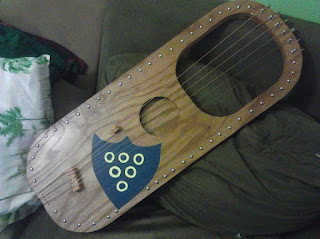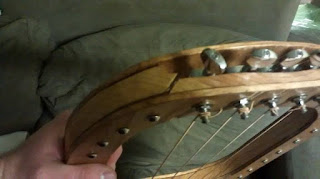 The first Instrument that I built was a 6-String Anglo Saxon Lyre. I'll make sure that I post blueprints whenever I find my originals ... or more likely redraw them. For now I'll post the final product.It made an excellent and relatively cheap starting project as the complete list of needs for this one was: a 2" (1.5") thick piece of wood for the frame and bridges (yes, look at the pic, there are 2 bridges), a piece of hardwood paneling for the front and back, 6 guitar tuning keys, package of guitar strings, wood glue, and polyurethane coating. I also used decorative furniture tacks too, and at the time I didn't think that they were necessary let alone helpful, but I experienced some issues that I think they have a hand in alleviating though. It's tuned go the first 6 steps of C (C, D, E, F, G, A) and doesn't include any frets or other way to change the note. That simply means that like a harp, each string is a note, and unlike a harp, it has a total of 6 notes. Because I'm using standard guitar strings I had to shorted the length of the Low E string with a separate bridge and in general overtighten the Low E, A and D strings to make then play the C3, D3, and E3. In doing this I can just buy a new pack of standard guitar strings and not order strings with a special diameter.
The first Instrument that I built was a 6-String Anglo Saxon Lyre. I'll make sure that I post blueprints whenever I find my originals ... or more likely redraw them. For now I'll post the final product.It made an excellent and relatively cheap starting project as the complete list of needs for this one was: a 2" (1.5") thick piece of wood for the frame and bridges (yes, look at the pic, there are 2 bridges), a piece of hardwood paneling for the front and back, 6 guitar tuning keys, package of guitar strings, wood glue, and polyurethane coating. I also used decorative furniture tacks too, and at the time I didn't think that they were necessary let alone helpful, but I experienced some issues that I think they have a hand in alleviating though. It's tuned go the first 6 steps of C (C, D, E, F, G, A) and doesn't include any frets or other way to change the note. That simply means that like a harp, each string is a note, and unlike a harp, it has a total of 6 notes. Because I'm using standard guitar strings I had to shorted the length of the Low E string with a separate bridge and in general overtighten the Low E, A and D strings to make then play the C3, D3, and E3. In doing this I can just buy a new pack of standard guitar strings and not order strings with a special diameter. The problem I ran into unfortunately, was due to poor planning. I didn't realize that adding more and more pressure to the strings would add more and more pressure to the wood as well. This lapse in common sense caused the wood to bow, and the wood bowing caused the lyre to be out of tune. It being Out of tune forced my to increase the pressure to the strings, and so on. Finally, the frame cracked. I added some screws to the damaged area (ugly) which holds it for now (ugly), but I'm still contending with the wood bowing (ugly), and I'm afraid that it may break in another spot too. For now though, it's a minor inconvenience that I'll need to remedy later.
The problem I ran into unfortunately, was due to poor planning. I didn't realize that adding more and more pressure to the strings would add more and more pressure to the wood as well. This lapse in common sense caused the wood to bow, and the wood bowing caused the lyre to be out of tune. It being Out of tune forced my to increase the pressure to the strings, and so on. Finally, the frame cracked. I added some screws to the damaged area (ugly) which holds it for now (ugly), but I'm still contending with the wood bowing (ugly), and I'm afraid that it may break in another spot too. For now though, it's a minor inconvenience that I'll need to remedy later.
No comments:
Post a Comment